NOx Emission Flux Measurements with Multiple Mobile-DOAS Instruments in Beijing
Abstract
1. Introduction
2. Experiment and Methodology
2.1. Experiment Overview
2.2. Mobile-DOAS
2.2.1. Mobile-DOAS Instrument
2.2.2. Retrieval Algorithm
2.2.3. Retrieval Comparison
2.3. Wind Field Measurement and Average Wind Field
2.3.1. Wind Profile Radar
2.3.2. Wind Field Statistics
2.4. Determination of the NOX Emission Flux
3. Results
3.1. Average Wind Field
3.2. Determination of NO2 VCD
3.3. Comparison of TROPOMI and Mobile-DOAS VCDs
4. Discussion
4.1. NOX Emission Flux Error Sources
4.2. NOX Emission Flux and Error
4.3. Error Budget and Sensitivity
4.3.1. Error Budget
4.3.2. Sensitivity to Wind Field Uncertainty
4.3.3. Sensitivity to Other Error Sources
5. Conclusions
Author Contributions
Funding
Conflicts of Interest
References
- Seinfeld, J.H.; Pandis, S.N. Atmospheric Chemistry and Physics: From Air Pollution to Climate Change; Wiley: Hoboken, NJ, USA, 2016. [Google Scholar]
- Cheng, L.X.; Tao, J.H.; Valks, P.; Yu, C.; Liu, S.; Wang, Y.; Xiong, X.Z.; Wang, Z.F.; Chen, L.F. NO2 Retrieval from the Environmental Trace Gases Monitoring Instrument (EMI): Preliminary Results and Intercomparison with OMI and TROPOMI. Remote Sens. 2019, 11, 3017. [Google Scholar] [CrossRef]
- Mak, H.W.L.; Laughner, J.L.; Fung, J.C.H.; Zhu, Q.; Cohen, R.C. Improved Satellite Retrieval of Tropospheric NO2 Column Density via Updating of Air Mass Factor (AMF): Case Study of Southern China. Remote Sens. 2018, 10, 1789. [Google Scholar] [CrossRef]
- Squires, F.A.; Nemitz, E.; Langford, B.; Wild, O.; Drysdale, W.S.; Acton, W.J.F.; Fu, P.; Grimmond, C.S.B.; Hamilton, J.F.; Hewitt, C.N.; et al. Measurements of traffic dominated pollutant emissions in a Chinese megacity. Atmos. Chem. Phys. 2020, 20, 8737–8761. [Google Scholar] [CrossRef]
- Wang, Y.; Tao, J.; Cheng, L.; Yu, C.; Wang, Z.; Chen, L. A Retrieval of Glyoxal from OMI over China: Investigation of the Effects of Tropospheric NO2. Remote Sens. 2019, 11, 137. [Google Scholar] [CrossRef]
- Wen, L.; Xue, L.; Wang, X.; Xu, C.; Chen, T.; Yang, L.; Wang, T.; Zhang, Q.; Wang, W. Summertime fine particulate nitrate pollution in the North China Plain: Increasing trends, formation mechanisms and implications for control policy. Atmos. Chem. Phys. 2018, 18, 11261–11275. [Google Scholar] [CrossRef]
- Zhang, H.X.; Liu, C.; Chan, K.L.; Hu, Q.H.; Liu, H.R.; Li, B.; Xing, C.Z.; Tan, W.; Zhou, H.J.; Si, F.Q.; et al. First observation of tropospheric nitrogen dioxide from the Environ-mental Trace Gases Monitoring Instrument onboard the GaoFen-5 satellite. Light Sci. Appl. 2020, 9, 66. [Google Scholar] [CrossRef] [PubMed]
- Zhang, Q.J.; Beekmann, M.; Freney, E.; Sellegri, K.; Pichon, J.M.; Schwarzenboeck, A.; Colomb, A.; Bourrianne, T.; Michoud, V.; Borbon, A. Formation of secondary organic aerosol in the Paris pollution plume and its impact on surrounding regions. Atmos. Chem. Phys. 2015, 15, 13973–13992. [Google Scholar]
- Wang, Y.; Beirle, S.; Lampel, J.; Koukouli, M.; De Smedt, I.; Theys, N.; Li, A.; Wu, D.; Xie, P.; Liu, C.; et al. Validation of OMI, GOME-2A and GOME-2B tropospheric NO2, SO2 and HCHO products using MAX-DOAS observations from 2011 to 2014 in Wuxi, China: Investigation of the effects of priori profiles and aerosols on the satellite products. Atmos. Chem. Phys. 2017, 17, 5007–5033. [Google Scholar] [CrossRef]
- Zhang, Q.; Zheng, Y.X.; Tong, D.; Shao, M.; Wang, S.X.; Zhang, Y.H.; Xu, X.D.; Wang, J.N.; He, H.; Liu, W.Q.; et al. Drivers of improved PM2.5air quality in China from 2013 to 2017. Proc. Natl. Acad. Sci. USA 2019, 116, 24463–24469. [Google Scholar] [CrossRef]
- Platt, U. Dry Deposition of SO2. Atmos. Environ. 1978, 12, 363–367. [Google Scholar] [CrossRef]
- Platt, U.; Stutz, J. Differential Optical Absorption Spectroscopy, Principles and Applications; Springer: Berlin/Heidelberg, Germany, 2008. [Google Scholar]
- Wagner, T.; Dix, B.; Friedeburg, C.V.; Frieß, U.; Sanghavi, S.; Sinreich, R. MAX-DOAS O4 measurements: A new technique to derive information on atmospheric aerosols—Principles and information content. J. Geophys. Res. 2004, 109, D22205. [Google Scholar] [CrossRef]
- Bortoli, D.; Silva, A.M.; Costa, M.J.; Domingues, A.F.; Giovanelli, G. Monitoring of atmospheric minor compounds at the Evora Station–Portugal. Int. J. Remote Sens. 2009, 30, 4209–4226. [Google Scholar] [CrossRef]
- Premuda, M.; Petritoli, A.; Masieri, S.; Palazzi, E.; Kostadinov, I.; Bortoli, D.; Ravegnani, F.; Giovanelli, G. A study of O3 and NO2 vertical structure in a coastal wooded zone near a metropolitan area, by means of DOAS measurements. Atmos. Environ. 2013, 71, 104–114. [Google Scholar] [CrossRef]
- Premuda, M.; Masieri, S.; Bortoli, D.; Kostadinov, I.; Petritoli, A.; Giovanelli, G. Evaluation of vessel emissions in a lagoon area with ground based Multi axis DOAS measurements. Atmos. Environ. 2011, 45, 5212–5219. [Google Scholar] [CrossRef]
- Wagner, T.; Ibrahim, O.; Shaiganfar, R.; Platt, U. Mobile MAX DOAS observations of tropospheric trace gases. Atmos. Meas. Tech. 2010, 3, 129–140. [Google Scholar] [CrossRef]
- Johanssona, M.; Galle, M.; Yu, T.; Tang, L.; Chen, D.L.; Li, H.J.; Li, J.X.; Zhang, Y. Quantification of total emission of air pollutants from Beijing using mobile mini-DOAS. Atmos. Environ. 2008, 42, 6926–6933. [Google Scholar] [CrossRef]
- Oetjen, H.; Baidar, S.; Krotkov, N.A.; Lamsal, L.N.; Lechner, M.; Volkamer, R. Airborne MAX-DOAS measurements over California: Testing the NASA OMI tropospheric NO2 product. J. Geophys. Res. Atmos. 2013, 118, 7400–7413. [Google Scholar] [CrossRef]
- Wang, P.; Richter, A.; Bruns, M.; Burrows, J.P.; Scheele, R.; Junkermann, W.; Heue, K.-P.; Wagner, T.; Platt, U.; Pundt, I. Airborne multi-axis DOAS measurements of tropospheric SO2 plumes in the Po-valley, Italy. Atmos. Chem. Phys. 2006, 6, 329–338. [Google Scholar] [CrossRef]
- Wang, R.W.; Xie, P.H.; Xu, J.; Li, A.; Sun, Y.W. Observation of CO2 Regional Distribution Using an Airborne Infrared Remote Sensing Spectrometer (Air-IRSS) in the North China Plain. Remote Sens. 2019, 11, 123. [Google Scholar] [CrossRef]
- Rivera, C.; Mellqvist, J.; Samuelsson, J.; Lefer, B.; Alvarez, S.; Patel, M.R. Quantification of NO2 and SO2 emissions from Houston Ship Channel and Texas City industrial areas during the 2006 Texas Air Quality Study. J. Geophys. Res. 2010, 115, D08301. [Google Scholar] [CrossRef]
- Constantin, D.-E.; Merlaud, A.; van Roozendael, M.; Voiculescu, M.; Fayt, C.; Hendrick, F.; Pinardi, G.; Georgescu, L. Measurements of Tropospheric NO2 in Romania Using a Zenith-Sky Mobile DOAS System and Comparisons with Satellite Observations. Sensors 2013, 13, 3922–3940. [Google Scholar] [CrossRef] [PubMed]
- Ibrahim, O.; Shaiganfar, R.; Sinreich, R.; Stein, T.; Platt, U.; Wagner, T. Car MAX-DOAS measurements around entire cities: Quantification of NOX emissions from the cities of Mannheim and Ludwigshafen (Germany). Atmos. Meas. Tech. 2010, 3, 709–721. [Google Scholar] [CrossRef]
- Frins, E.; Bobrowski, N.; Osorio, M.; Casaballe, N.; Belsterli, G.; Wagner, T.; Platt, U. Scanning and mobile multi-axis DOAS measurements of SO2 and NO2 emissions from an electric power plant in Montevideo, Uruguay. Atmos. Environ. 2014, 98, 347–356. [Google Scholar] [CrossRef]
- Davis, Z.Y.W.; Baray, S.; McLinden, C.A.; Khanbabakhani, A.; Fujs, W.; Csukat, C.; Debosz, J.; McLaren, R. Estimation of NOX and SO2 emissions from Sarnia, Ontario, using a mobile MAX-DOAS (Multi-AXis Differential Optical Absorption Spectroscopy) and a NOX analyzer. Atmos. Chem. Phys. 2019, 19, 13871–13889. [Google Scholar] [CrossRef]
- Rivera, C.; Sosa, G.; Wöhrnschimmel, H.; de Foy, B.; Johansson, M.; Galle, B. Tula industrial complex (Mexico) emissions of SO2 and NO2 during the MCMA 2006 field campaign using a mobile mini-DOAS system. Atmos. Chem. Phys. 2009, 9, 6351–6361. [Google Scholar] [CrossRef]
- Rivera, C.; Barrera, H.; Grutter, M.; Zavala, M.; Galle, B.; Bei, N.F.; Li, G.H.; Molina, L.T. NO2 fluxes from Tijuana using a mobile mini-DOAS during Cal-Mex 2010. Atmos. Environ. 2012, 70, 532–539. [Google Scholar] [CrossRef]
- Shaiganfar, R.; Beirle, S.; Sharma, M.; Chauhan, A.; Singh, R.P.; Wagner, T. Estimation of NOX emissions from Delhi using Car MAX-DOAS observations and comparison with OMI satellite data. Atmos. Chem. Phys. 2011, 11, 10871–10887. [Google Scholar] [CrossRef]
- Wang, S.S.; Zhou, B.; Wang, Z.R.; Yang, S.N.; Hao, N.; Valks, P.; Trautmann, T.; Chen, L.M. Remote sensing of NO2 emission from the central urban area of Shanghai (China) using the mobile DOAS technique. J. Geophys. Res. 2012, 117, D13305. [Google Scholar] [CrossRef]
- Shaiganfar, R.; Beirle, S.; Denier van der Gon, H.; Jonkers, S.; Kuenen, J.; Petetin, H.; Zhang, Q.; Beekmann, M.; Wagner, T. Estimation of the Paris NOX emissions from mobile MAX-DOAS observations and CHIMERE model simulations during the MEGAPOLI campaign using the closed integral method. Atmos. Chem. Phys. 2017, 17, 7853–7890. [Google Scholar] [CrossRef]
- Tan, W.; Zhao, S.H.; Liu, C.; Chan, K.L.; Xie, Z.Q.; Zhu, Y.; Sub, W.J.; Zhang, C.X.; Liu, H.R.; Xing, C.Z.; et al. Estimation of winter time NOX emissions in Hefei, a typical inland city of China, using mobile MAX-DOAS observations. Atmos. Environ. 2019, 200, 228–242. [Google Scholar] [CrossRef]
- Danckaert, T.; Fayt, C.; van Roozendael, M.; de Smedt, I.; Letocart, V.; Merlaud, A.; Pinardi, G. QDOAS Software User Manual. 2017. Available online: http://uv-vis.aeronomie.be/software/QDOAS/QDOAS_manual.pdf (accessed on 9 September 2017).
- Wu, F.C.; Li, A.; Xie, P.H.; Chen, H.; Hu, Z.K.; Zhang, Q.; Liu, J.G.; Liu, W.Q. Emission Flux Measurement Error with a Mobile DOAS System and Application to NOX Flux Observations. Sensors 2017, 17, 231. [Google Scholar] [CrossRef] [PubMed]
- Wu, F.; Xie, P.; Li, A.; Mou, F.; Chen, H.; Zhu, Y.; Zhu, T.; Liu, J.; Liu, W. Investigations of temporal and spatial distribution of precursors SO2 and NO2 vertical columns in the North China Plain using mobile DOAS. Atmos. Chem. Phys. 2018, 18, 1535–1554. [Google Scholar] [CrossRef]
- Wu, F.C.; Xie, P.H.; Li, A.; Chan, K.L.; Hartl, A.; Wang, Y.; Si, F.Q.; Zeng, Y.; Qin, M.; Xu, J.; et al. Observations of SO2 and NO2 by mobile DOAS in the Guangzhou eastern area during the Asian Games 2010. Atmos. Meas. Tech. 2010, 6, 2277–2292. [Google Scholar] [CrossRef]
- Deutschmann, T.; Beirle, S.; Frieß, U.; Grzegorski, M.; Kern, C.; Kritten, L.; Platt, U.; Prados-Roman, C.; Pukite, J.; Wagner, T.; et al. The Monte Carlo atmospheric radiative transfer model McArtim: Introduction and validation of Jacobians and 3-D features. J. Quant. Spectrosc. Radiat. Transf. 2011, 112, 1119–1137. [Google Scholar] [CrossRef]
- Farrugia, P.S.; Micallef, A. Vectorial statistics for the standard deviation of wind direction. Meteorol. Atmos. Phys. 2017, 129, 495–506. [Google Scholar] [CrossRef]
- Bowers, J.A.; Morton, I.D.; Mould, G.I. Mould. Directional statistics of the wind and waves. Appl. Ocean. Res. 1999, 22, 13–30. [Google Scholar] [CrossRef]
- Mardia, K.V.; Peter, E.J. Directional Statistics; John Wiley & Sons: Chichester, UK, 1999. [Google Scholar]
- Li, A.; Zhang, J.; Xie, P.H.; Hu, Z.K.; Xu, J.; Mou, F.S.; Wu, F.C.; Liu, J.G.; Liu, W.Q. Variation of temporal and spatial patterns of NO2 in Beijing using OMI and mobile DOAS. Sci. China Chem. 2015, 58, 1367–1376. [Google Scholar] [CrossRef]
- Steffen Beirle, S.; Borger, C.; Dörner, S.; Li, A.; Hu, Z.K.; Liu, F.; Wang, Y.; Wagner, T. Pinpointing nitrogen oxide emissions from space. Sci. Adv. 2019, 5, eaax9800. [Google Scholar] [CrossRef]
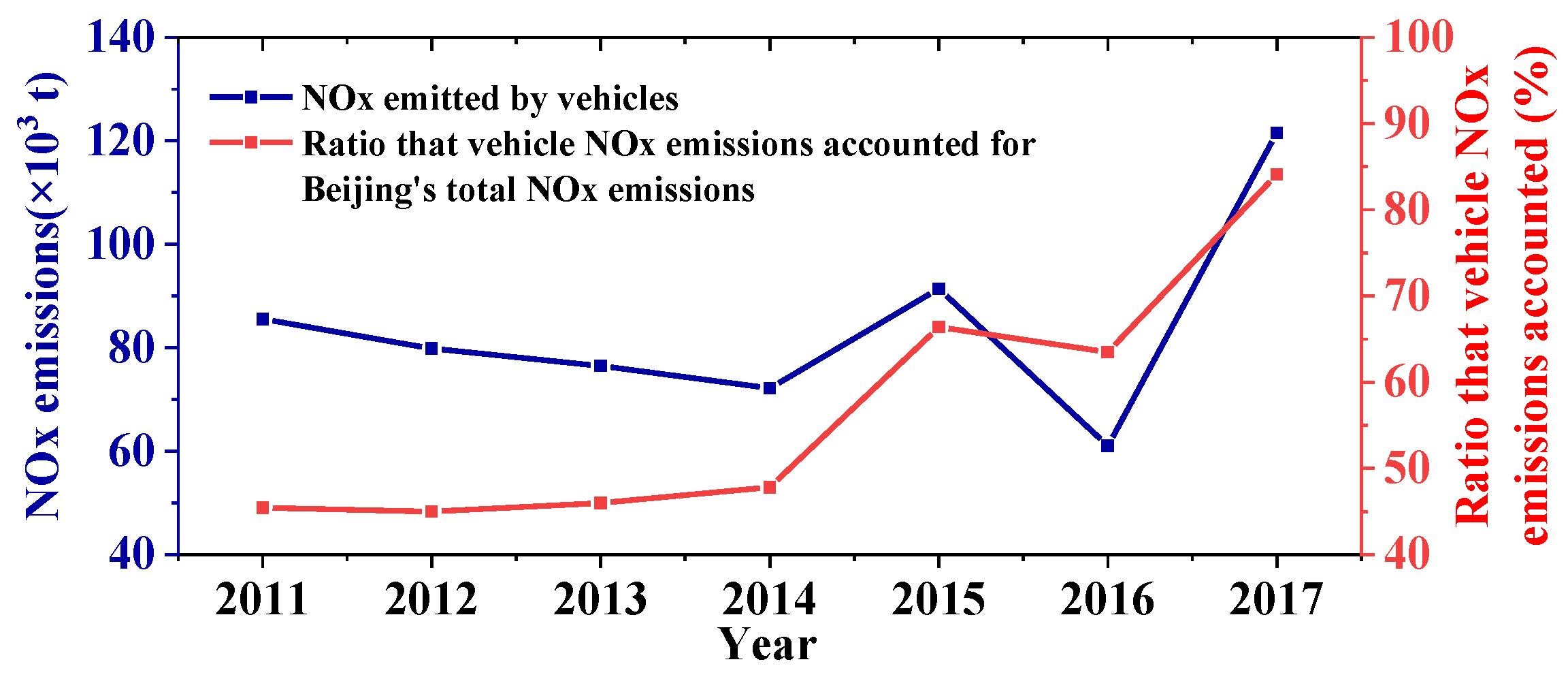



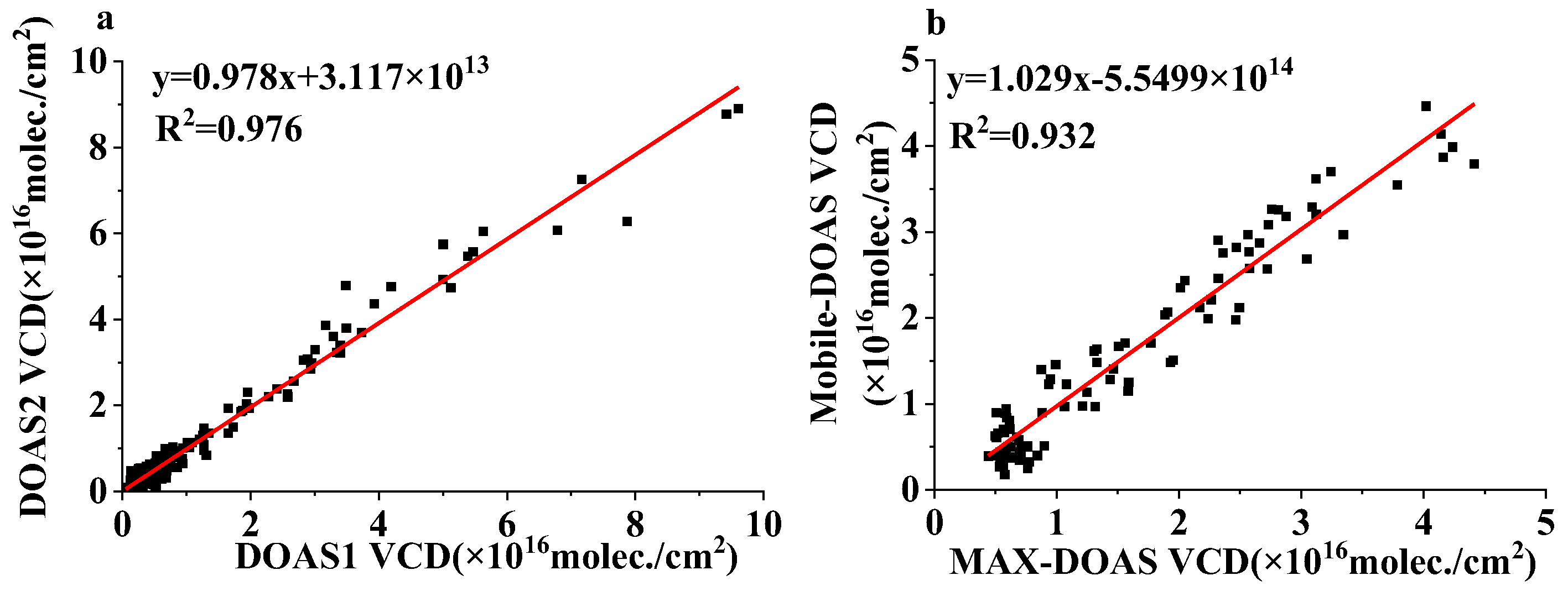




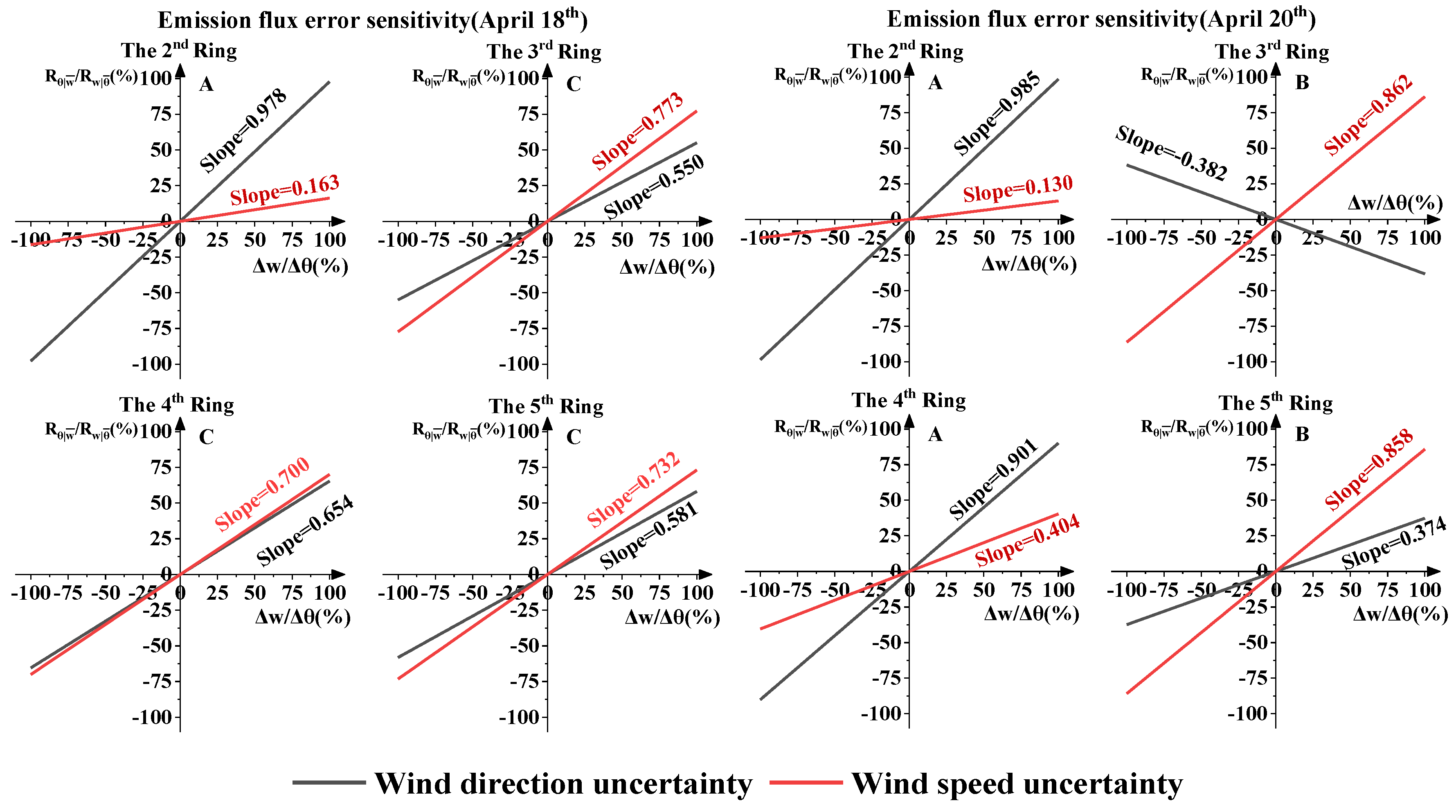
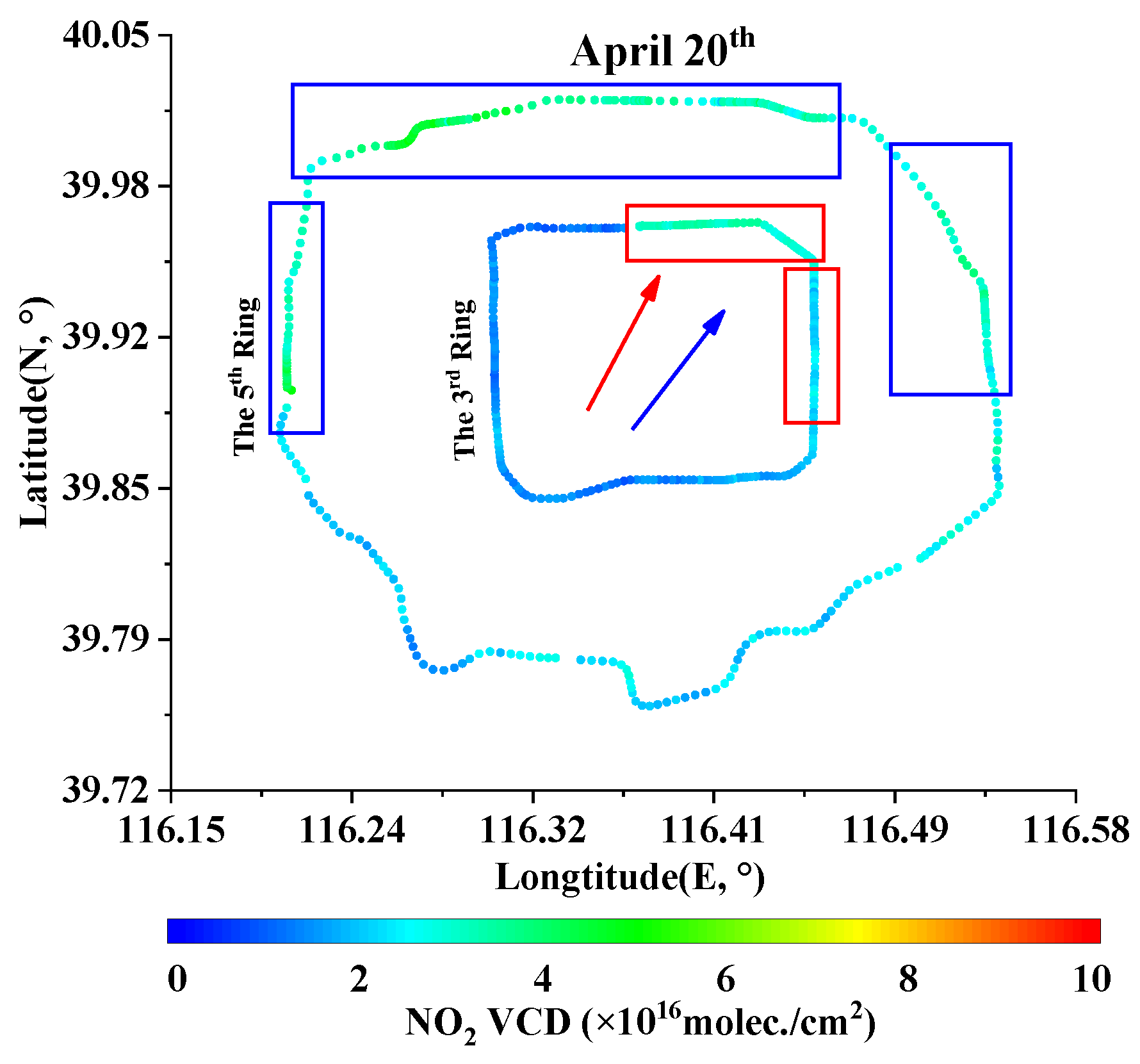
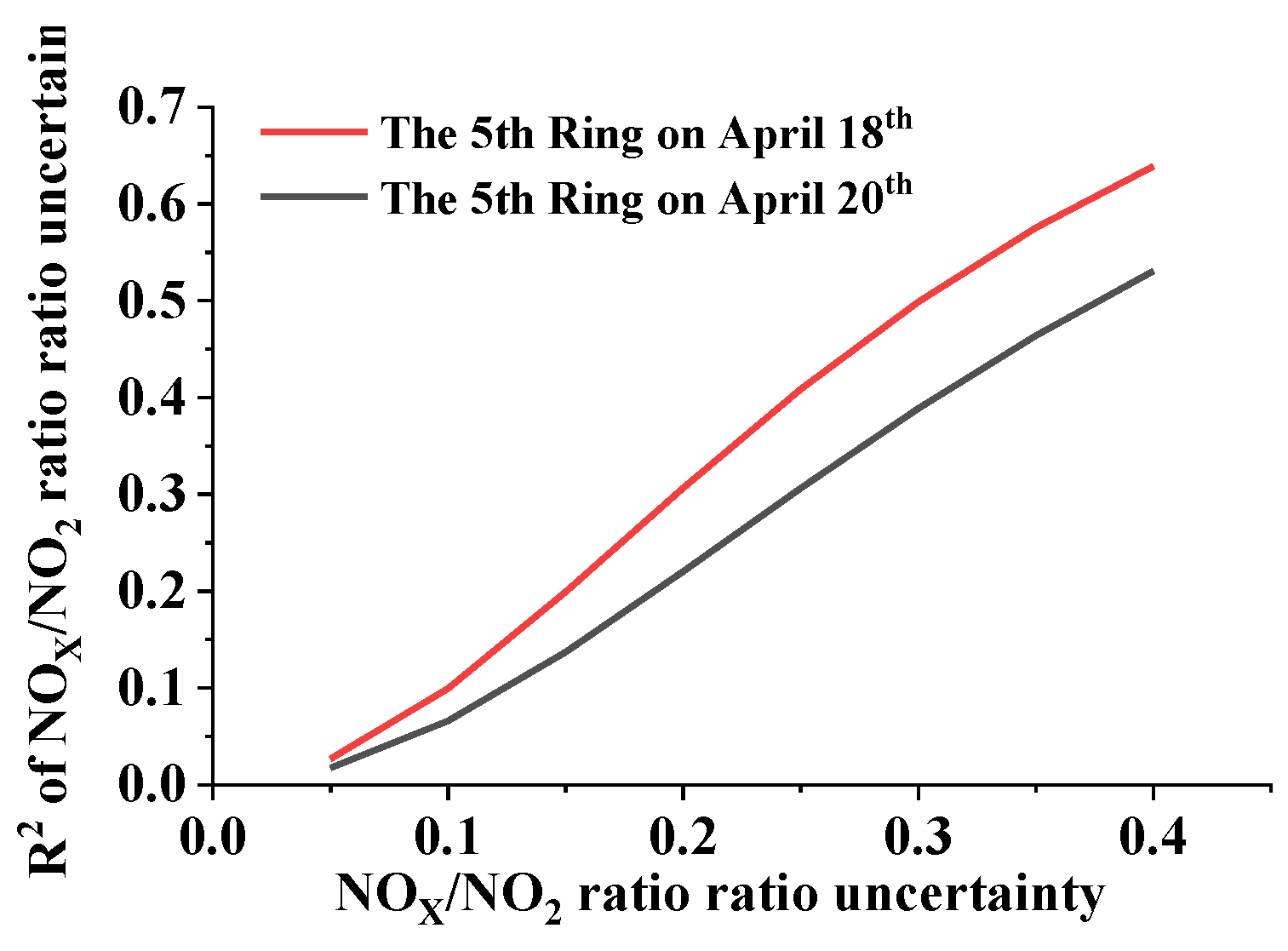
| Fitting Parameter | NO2 |
|---|---|
| Fitting windows | (338~370) nm |
| Polynomial order | 5 |
| NO2 | Vandaele, 1996 (220K, 298k) |
| O3 | Bogumil, 2003 (223K, 243K) |
| O4 | Thalman, 2013 (293K) |
| HCHO | Meller, 2000 (297K) |
| Ring | by DOASIS |
| Date (2018) | Ring Roads and Measuring Time (Beijing Time) | Averaged Wind Speed and Its Uncertainty (m/s) | Averaged Wind Direction and Its Uncertainty (°) |
|---|---|---|---|
| April 18th | The second ring (12:40~13:27) | 2.325 ± 0.643 | 55.644 ± 17.039 |
| The third ring (12:03~13:11) | 2.285 ± 0.638 | 65.176 ± 13.735 | |
| The fourth ring (9:39~11:24) | 1.738 ± 0.501 | 70.651 ± 17.302 | |
| The fifth ring (9:27~11:56) | 1.736 ± 0.494 | 67.317 ± 15.497 | |
| April 20th | The second ring (13:18~14:32) | 2.905 ± 0.779 | 68.607 ± 15.859 |
| The third ring (12:01~13:21) | 3.553 ± 0.959 | 64.944 ± 13.220 | |
| The fourth ring (9:33~11:21) | 3.423 ± 0.919 | 61.889 ± 20.926 | |
| The fifth ring (9:24~12:22) | 3.501 ± 0.942 | 60.662 ± 15.265 | |
| April 24th | The second ring (11:24~12:15) | 2.183 ± 0.551 | 255.665 ± 13.897 |
| The third ring (9:56~11:03) | 2.721 ± 0.704 | 260.323 ± 20.409 | |
| The fourth ring (11:09~12:47) | 1.973 ± 0.512 | 255.457 ± 13.760 | |
| The fifth ring (9:41~11:03) | 2.83 ± 0.737 | 260.666 ± 21.051 | |
| April 25th | The second ring (13:19~14:07) | 2.826 ± 0.730 | 44.126 ± 8.448 |
| The third ring (12:28~13:36) | 2.621 ± 0.676 | 43.218 ± 9.216 | |
| The fourth ring (11:03~12:26) | 1.956 ± 0.545 | 41.982 ± 21.501 | |
| The fifth ring (9:58~12:28) | 2.14 ± 0.582 | 45.945 ± 19.045 | |
| April 26th | The second ring (12:08~13:30) | 1.912 ± 0.506 | 273.92 ± 17.226 |
| The third ring (11:36~13:10) | 1.537 ± 0.413 | 276.556 ± 15.009 | |
| The fourth ring (9:42~11:32) | 1.686 ± 0.459 | 255.23 ± 14.349 | |
| The fifth ring (9:33~11:53) | 1.571 ± 0.431 | 254.648 ± 14.211 |
© 2020 by the authors. Licensee MDPI, Basel, Switzerland. This article is an open access article distributed under the terms and conditions of the Creative Commons Attribution (CC BY) license (http://creativecommons.org/licenses/by/4.0/).
Share and Cite
Huang, Y.; Li, A.; Xie, P.; Hu, Z.; Xu, J.; Fang, X.; Ren, H.; Li, X.; Dang, B. NOx Emission Flux Measurements with Multiple Mobile-DOAS Instruments in Beijing. Remote Sens. 2020, 12, 2527. https://doi.org/10.3390/rs12162527
Huang Y, Li A, Xie P, Hu Z, Xu J, Fang X, Ren H, Li X, Dang B. NOx Emission Flux Measurements with Multiple Mobile-DOAS Instruments in Beijing. Remote Sensing. 2020; 12(16):2527. https://doi.org/10.3390/rs12162527
Chicago/Turabian StyleHuang, Yeyuan, Ang Li, Pinhua Xie, Zhaokun Hu, Jin Xu, Xiaoyi Fang, Hongmei Ren, Xiaomei Li, and Bing Dang. 2020. "NOx Emission Flux Measurements with Multiple Mobile-DOAS Instruments in Beijing" Remote Sensing 12, no. 16: 2527. https://doi.org/10.3390/rs12162527
APA StyleHuang, Y., Li, A., Xie, P., Hu, Z., Xu, J., Fang, X., Ren, H., Li, X., & Dang, B. (2020). NOx Emission Flux Measurements with Multiple Mobile-DOAS Instruments in Beijing. Remote Sensing, 12(16), 2527. https://doi.org/10.3390/rs12162527





